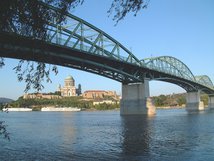Esztergom-Štúrovo
Countries: Hungary , SlovakiaRegions concerned: Komárom-Esztergom county (Hungary), Nitra region (Slovakia)
Overview
The towns of Esztergom (Hungary, 30,858 inhabitants) and Štúrovo (Slovakia, 10,851) are situated on opposite sides of the river Danube, at the border between Hungary and Slovakia. With a number of other neighbouring towns (Dorog, Nyergesújfalu, Lábatlan…) they form a cross-border conurbation of around 90,000 inhabitants, which was behind the formation of the “Ister-Granum” Euroregion. The Hungarian side is more urbanised and more densely populated (69% of the Euroregion’s population), while the Slovak side is more rural (composed of small villages, with the exception of the towns Štúrovo and Želiezovce).
Cross-border cooperation here is relatively recent. The first stage of cooperation began with the twinning of the two towns in 1991. Between 2008 and 2010, the towns participated in the EU URBACT project “EGTC” ("Expertising Governance for Transfrontier Conurbations"), notably in order to work towards a local strategic plan for cross-border governance. In May 2008, the elected representatives of the two towns signed a convention formalising the two municipalities’ entry into the EGTC of the Ister-Granum Euroregion. This EGTC was the first of its kind to be established in Eastern Europe.
General context
Esztergom and Štúrovo have been twin towns since the 11th century. In 1920, following the peace treaties marking the end of the First World War, they formed part of two different independent states (Štúrovo in Czechoslovakia, then Slovakia since 1993; Esztergom in Hungary). Today, Hungarians represent the largest ethnic minority in Slovakia (9.7% of the population). For the most part they live in the southern part of the country, notably in the Slovakian portion of the Euroregion.
The Mária Valéria Bridge between the two towns, destroyed during the Second World War then reconstructed in 2001, was the starting point for the recent integration of the two towns within a cross-border space. Cross-border flows in both directions have been increasing ever since, especially cross-border workers. Today, around 2,500 people from Štúrovo cross the border every day to go to work in Esztergom (principally in the Suzuki factory).
From an economic point of view, the two towns are relatively complementary. Jobs are concentrated on the Hungarian side of the border, more industrialised and urbanised, and unemployment is low (less than 5% in 2008). With 6,000 employees, (2300 of whom are Slovak citizens), the car manufacturer Suzuki is the main employer in the Euroregion. The Slovak part of the territory is more rural, with small villages and a higher rate of unemployment (10%), which has however been falling since 2001.


